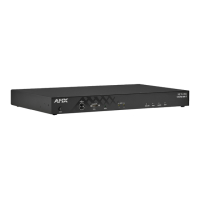NetLinx Programming
120
TPI-PRO-DVI - Instruction Manual
^RAF, ^RMF - Embedded Codes
The ^RAF and ^RMF commands add and modify any and all resource parameters by sending embedded codes and data:
"'^RAF-<resource name>,<data>'"
"'^RMF-<resource name>,<data>'"
The <data> variable uses the embedded codes described in the following table:
Dynamic Image Commands (Cont.)
^RFR Force a refresh for a given resource.
Syntax:
"'^RFR-<resource name>'"
Variable:
resource name = 1 - 50 ASCII characters.
Example:
SEND_COMMAND Panel,"'^RFR-Sports_Image'"
Forces a refresh on ’Sports_Image’.
^RMF Modifies any and all resource parameters by sending embedded codes and data. Since the embedded codes are preceded by a '%'
character, any '%' character contained in the URL must be escaped with a second '%' character (see example).
The file name field (indicated by a %F embedded code) may contain special escape sequences as shown in the ^RAF, ^RMF -
Embedded Codes section on page 120.
Syntax:
"'^RMF-<resource name>,<data>'"
Variables:
• resource name = 1 - 50 ASCII characters
• data = Refers to the embedded codes, see the ^RAF, ^RMF - Embedded Codes section on page 120.
Example:
SEND_COMMAND Panel,"'^RMF-Sports_Image,%ALab%%5FTest/Images%Ftest.jpg'"
Changes the resource ’Sports_Image’ file name to ’test.jpg’ and the path to ’Lab_Test/Images’. Note that the %%5F in the file
path is actually encoded as %5F.
^RSR Change the refresh rate for a given resource.
Syntax:
"'^RSR-<resource name>,<refresh rate>'"
Variable:
resource name = 1 - 50 ASCII characters.
refresh rate = Measured in seconds.
Example:
SEND_COMMAND Panel,"'^RSR-Sports_Image,5'"
Sets the refresh rate to 5 seconds for the given resource (’Sports_Image’).
^RAF, ^RMF - Embedded Codes
Parameter Embedded Code Description
protocol
’%P <0-1>’
Set protocol. HTTP (0) or FTP (1).
user
’%U <user>’
Set Username for authentication.
password
’%S <password>’
Set Password for authentication.
host
’%H <host>’
Set Host Name (fully qualified DNS or IP Address).
file
’%F <file>’
Full path to the location of the file or program that will return the resource. The path must be a
valid HTTP URL minus the protocol and host. The only exception to this is the inclusion of
special escape sequences and in the case of FTP protocol, regular expressions.
path
’%A <path>’
Set Directory path. The path must be a valid HTTP URL minus the protocol, host and filename.
The only exception to this is the inclusion of special escape sequences and in the case of FTP
protocol, regular expressions.
refresh
’%R <refresh 1-65535>’
The number of seconds between refreshes in which the resource is downloaded again.
Refreshing a resource causes the button displaying that resource to refresh also. The default
value is 0 (only download the resource once).
newest
’%N <0-1>’
Set the newest file. A value of 1 means that only the most recent file matching the pattern is
downloaded.
Note: The 'newest f ile' option only applies to FTP Dynamic Images, and only those that have
pattern matching as part of their filename. Neither 'newest f ile' nor pattern matching apply to
HTTP Dynamic Images. When set, the panel will f irst pull a list of f iles matching the given pattern
from the specified FTP server and path. The timestamps of the items in the list will be compared,
with the newest one being displayed on the panel. This is useful for source devices that place a
uniquely named still image in a folder at constant intervals, allowing the panel always to display
the most recent one.
preserve
’%V <0-1>’
Set the value of the preserve flag. Default is 0. Currently preserve has no function.

